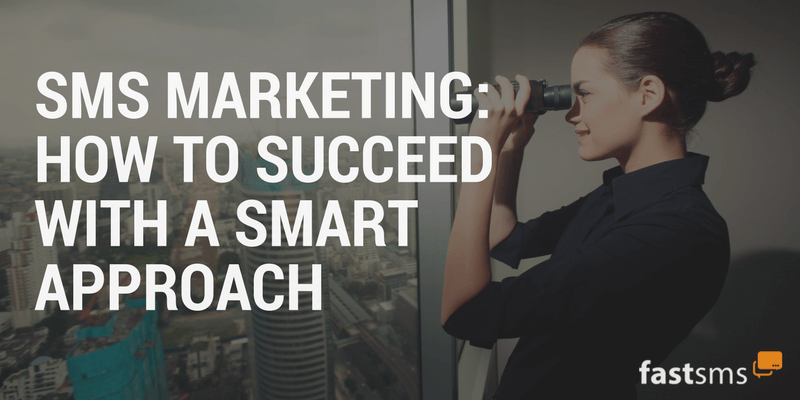SMS Marketing – How to Succeed with a SMART Approach

SMS Marketing is a popular form of marketing that is very affordable even for the smallest of businesses and, if used properly, can offer incredible ROI. One of the key advantages SMS marketing has over other channels is incredible reach and open rates. It is also felt by the majority of customers to be one of the most personalised ways in which companies can communicate.
In order to unlock the true potential of this incredible channel, it is essential to adopt a clear strategy from the outset – and SMART principles are a great way to make sure your campaign meets its objectives.
What are SMART goals?
Most people in business will be more than familiar with setting and using SMART goals, but in order to get the most out of this article, let’s take a moment to remind ourselves what they are all about. SMART is a mnemonic acronym for a set of criteria which are often used as a planning tool that brings structure and trackability to goals and objectives. The letters generally represent the following:
S – Specific
M – Measurable
A – Achievable
R – Realistic
T – Timely
With this in mind, let’s look in more detail about how each of these might be applied to a successful SMS Marketing campaign.
Specific
As with any marketing campaign, it is essential to begin with a specific objective in mind. This is likely to be different depending on your sector. For example, a travel agent or loans company might aim to achieve ca certain number of return customers, whilst a gym might wish to see a specific percentage of subscriptions. One of the attractions of SMS messaging is the very limited number of characters allowed – meaning that the message must be succinct and this will likely be reflected in the ‘Specific’ element of your strategy.
Measurable
Assuming that highly specific goals or objectives have been set in the previous step, the measurability should be reasonably obvious. In many cases, the key measurable will be directly tied to the ROI, and therefore typically be based on the actual financial value of transactions generated i.e to generate a specific value of sales.
Other campaigns may be percentage based. If your goal was to see 20% of customers book a second holiday, then the measurable is again inherent in the objective.
It is worth noting that both of the above goals are based on a sales-based campaign objective. Other objectives such as increased reach or improved customer relations can be much harder to quantify.
Achievable
So we have a clear objective and we have a measure. How do we go about ensuring the campaign is achievable? The first element to consider here is metrics. Let’s imagine you are planning to send 15,000 SMS messages. How many responses can you reasonably expect to get? What would be an achievable conversion rate?
As with any approach to marketing, understanding customer behaviours and adapting to fit is also key. Making sure that there is a clear and easy to follow CTA is an obvious must. You want the recipient of an SMS Marketing message to understand what it is they should do.
One popular and effective way to enhance the achievability of a campaign is through the use of SMS keywords. These allow a recipient to instantly respond with a specific, automated action.
For example, you might use a message that reads as follows:
“David, as a loyal customer you’ve been pre-approved for a loan of £2500. Text YES to 87007 to apply today. See Kwikloans.co.uk for T&C’s”
In this example, the customer can see instantly how to take the desired action (accept the loan) as well as find any further information they might wish to see before making the decision. Because we have made the message time bound (apply today) and personal to the customer (using their name, stating they have been pre-selected)*, we have significantly increased the achievability. Imagine if, instead, we had sent the following:
“Want to know if you qualify for a £2500 loan? Why not visit Kwikloans.co.uk and fill in our online application form for a quick decision.”
In this example, we have severely limited the achievability of triggering the desired action and our campaign objectives are unlikely to be achieved.
Realistic
Again, we must consider the same two points in setting a realistic campaign objective – financial metrics and customer behaviour.
In terms of the financials, we can often use internal data such as historical conversion rates and typical transactional values per customer / per visit etc to establish realistic expectations. CRM systems often offer a wealth of data that can help in this aspect of your planning.
With Fastsms as your business SMS partner, you have access to fully supported API integration that is compatible with most industry standard CRM platforms including SalesForce, Zoho CRM Pipedrive, Oracle and Microsoft Dynamics 365 CRM. To learn more about our API integration click here.
With customer behaviour, it is essential to consider carefully the characteristics of both your chosen segment and SMS as a medium.
Timely
When it comes to marketing, timeliness typically refers to a given financial reporting period – usually monthly or quarterly – and the campaign should be designed to reflect this.
One way in which we can help to achieve the desired outcomes in a timely manner is to state the period of validity in our communications, encouraging the recipient to act on our timescale rather than one of their own. This is a technique that was demonstrated in the example message previously shown.
You may also wish to design a campaign that allows for follow-up messages to be sent out if no initial response is required. In such an approach, a suitable timeframe for each stage should be considered.
At Fastsms, we offer you all the support you need to get your SMS Marketing campaign off to a successful start. Our exceptional customer support team is accessible 24/7, and we can also connect you with a knowledgeable account manager for your sector if you require further support. Give us a call now on 0800 954 5305 or sign up for a free account today to receive 100 free texts.
* please note that this example is for illustrative purposes only. Financial compliance rules may also apply in addition to the general rules set out in UK marketing and telecommunications legislation.
Related Articles
5 Ways Restaurants can use SMS Marketing for a Festive Full House
Using SMS to support drive-to-web strategies
Copywriting Principles for SMS Marketing
In a recent post I covered how to create urgency in your SMS marketing messages. It didn't feel right to leave out a few other key components - the U companions. In copywriting circles they are often called the 4-Us. They are: Urgent, Useful, Unique, and Ultra-specific. So to make sure I don't leave anything out, here I'll show you how to use the others in your SMS messaging.
Referral Marketing Through SMS Messaging
What is one almost guaranteed way of getting new customers? Ask for them. Really. Studies show that 83% of satisfied customers are willing to recommend a company, product or service to their family and friends. Here's how you can use SMS to simplify and improve your referral marketing.
9 Football Phrases to Kick Start Your World Cup SMS Marketing Campaign
Apps vs SMS: Why Your Marketing Messages Work Better via Text Message
With the rise of the app, some marketers have been quick to sound the death knell for the SMS. But reports of the SMS's death have been greatly exaggerated. With over 76% of the UK population now dependent on their smartphones for everything from news to personal communication, the SMS remains a great tool to directly engage with your customers.
An A-Z of SMS Marketing: D is for Distribution List [Infographic]
Salesforce Finds SMS Messaging a Growing Part of Mobile Marketing Strategy
What do 5,000 marketers from ten different countries say about SMS? It’s great, and we’re going to do more of it. Well, that’s the gist of the results in the Salesforce 2015 State of Marketing Report. Mobile marketing has taken a central place in most company’s strategies, and SMS is a growing part of it. Here are some key statistics from the report.











